How to choose and use laminate flooring in the kitchen?
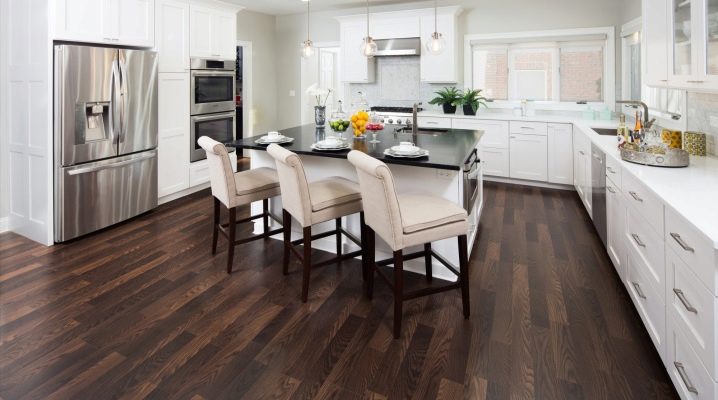
Laminate is a beautiful and modern finish that fits perfectly into any interior. But the appropriateness of its use in the kitchen is often in doubt, because in this room various unforeseen situations are possible: spilled water, stains of various origins, falling of rather heavy objects. Can laminate flooring meet the increased strength requirements or should you choose a different kitchen floor covering?
Advantages and disadvantages
The use of laminate in the kitchen has both positive and negative sides, but with the right approach, the disadvantages can be avoided.
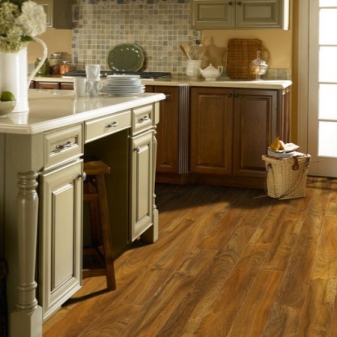
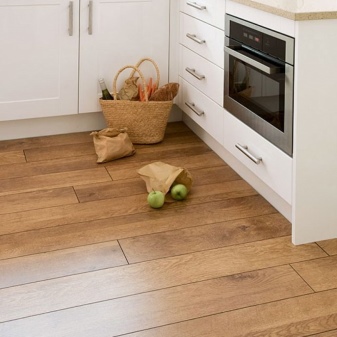
pros
- Comfort. Most of us spend a lot of time in the kitchen, and a warm floor under our feet is a very important point. Laminate flooring itself is much warmer than many others, and certain types of it allow you to make a warm floor.
- Strength. High-quality laminate is not afraid of direct sunlight and temperature changes, it is durable, liquids and stains of various origins are easily removed from it. Mechanical damage does not cause significant harm to it. Even moving furniture, stove or refrigerator, you can not be afraid of dents.
- Aesthetics. A variety of colors, the ability to choose a coating that imitates tiles, wood, stone - all these qualities can satisfy the most demanding taste.
- Practicality. Unlike natural materials, laminate flooring is quite affordable in price, and its installation will not cause any particular difficulties even for beginners. In addition, dropped dishes are likely to survive, and for children, such a floor is the least traumatic.
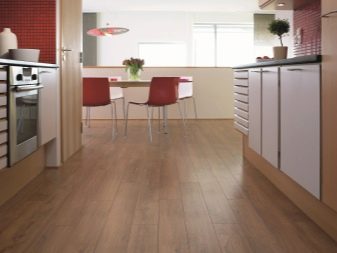
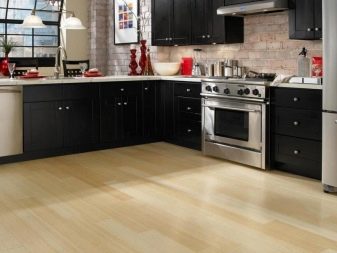
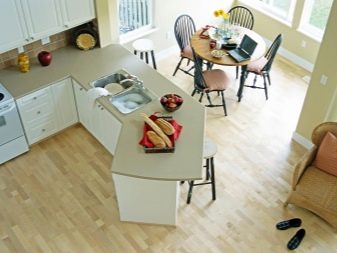
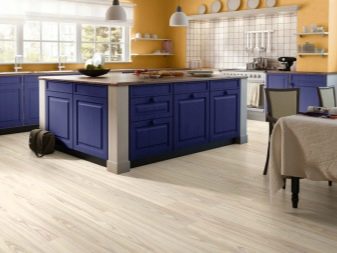
Minuses
Coating behavior in case of possible contact with water. The likelihood of this in the kitchen is very high. A pipe break, especially with hot water, can be disastrous. It is quite possible to avoid them. There are two types of laminate: moisture resistant and waterproof. They are made from different materials and behave differently when in contact with large amounts of water.
The protective layer covering the moisture-resistant laminate and special wax compounds that are impregnated with the joints of the locks on the plates can save you from a small amount of water. It needs to be removed as quickly as possible. If water seeps into the joints, the floor will swell and deform.
If the coating is susceptible to such damage, then it will not be possible to replace individual plates, you will have to change the entire surface.

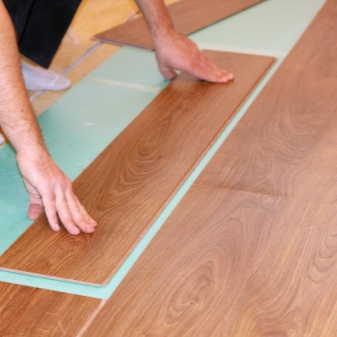
The basis of the waterproof laminate is plastic, so such problems do not threaten it, in case of possible deformation of one board, you can replace only it without changing the entire floor. But its cost is higher and the choice is not so wide. Special sealants for the treatment of seams can save you from dampness. This is not a panacea for deep flooding, but an essential salvation from spilled moisture. Amplification of sounds and creaking. If a special noise-insulating underlay or cork base is not laid between the base and the coating, an air gap will form. As a result, the sound of footsteps and falling objects will be amplified many times over, the claws of pets will clatter loudly, and the sound of heels will seem like a drumbeat.
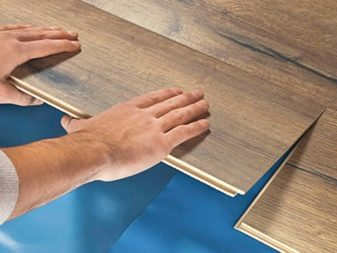
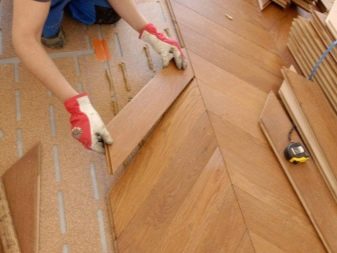
In addition, such a backing will smooth out irregularities in the underlying surface and eliminate the squeak that can occur over time.
- Possible damage. In a kitchen, it is difficult to avoid chips, scratches and other troubles, so it makes sense to purchase a special wax crayon of a suitable color to mask them.
- Potential harm to health. There are many manufacturers, some of them use materials containing harmful substances. This can be avoided by giving preference to a high-quality laminate and observing the recommendations for use.
But even these disadvantages can be eliminated by carefully studying the types of products offered.
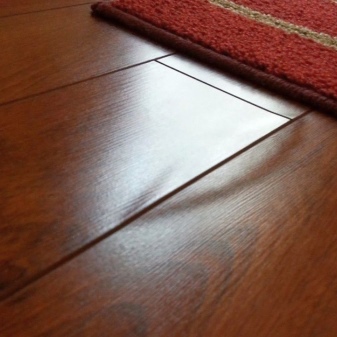
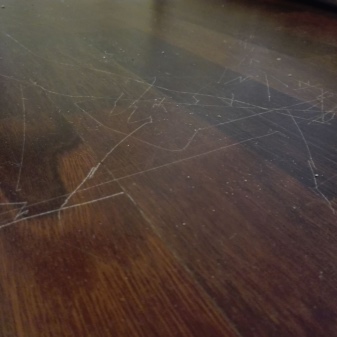
Views
The laminated coating is divided into several classes, which are designated by numbers 21-23 and 31-34. The first number indicates the scope of the laminate flooring. The group of coatings of the second class is used in residential premises, the third - in commercial. Currently, the second class laminate is rarely used, the third class group took the leading position. The cost of these panels is higher, but they last much longer.
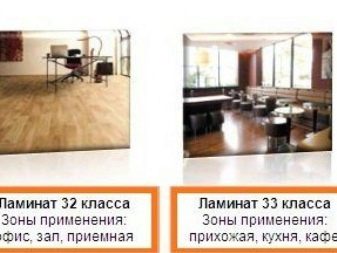
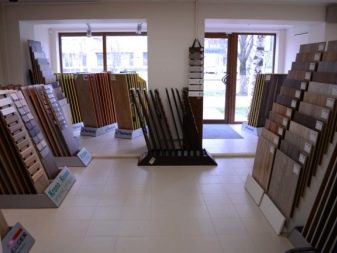
These types of laminate flooring differ in the following characteristics.
- Class 31 will last no more than 12 years and is intended for residential and commercial premises with medium traffic.
- Class 32 more resistant to various mechanical damages, has a service life of up to 15 years and permeability is above average.
- In rooms with high traffic, where there is a high probability of damage and prolonged contact with water, it is recommended laminate 33-34 class, the service life of which is more than 20 years. In a residential environment, some manufacturers provide a lifetime warranty for this class of coverage.

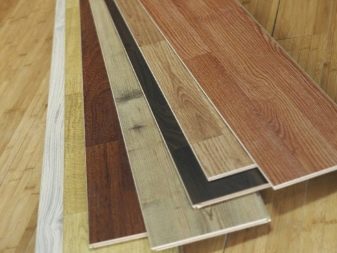
Laminate flooring consists of several layers, each of which has its own function.
- Stabilizing. It is performed by the first layer, which is Kraft cardboard impregnated with synthetic resins. It gives the boards of the covering rigidity and strength, does not allow them to deform.
- Carrier. This is the function of the second layer - fiberboard (fiberboard), which bears the main load, retains heat and resists moisture. It is the quality and density of fiberboard that determine the degree of moisture resistance of the laminate.
- Decorative. The third layer can be paper, foil or veneer. It is on it that the pattern is applied.
- The last layer protects the board from external influences. It is a thin but durable film of melamine or acrylic resin. It is she who is exposed to abrasion, physical or chemical damage, gives the coating the final gloss.
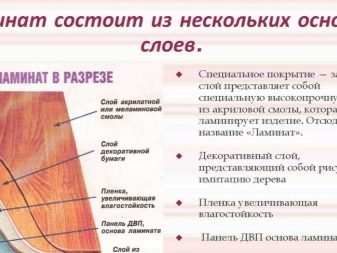
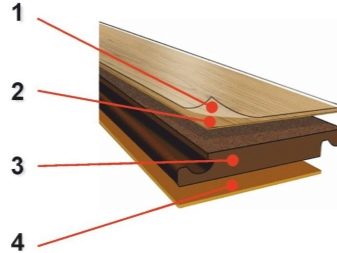
For a laminate intended for the kitchen, the main requirement will be the high quality of all layers and compliance with the 33 class of strength. More recently, along with the usual laminate, vinyl-based flooring has been used. Outwardly, they differ little. Instead of a wood base (usually pressed sawdust), it uses polyvinyl chloride (PVC).
It is a hard thermoplastic with plasticizers added for elasticity.


The bottom layer of PVC plates can be like a regular laminate - wood, but it can be without it. These two-layer vinyl boards are sometimes referred to as soft, or rubber. Vinyl laminate without wood base does not swell when exposed to moisture, does not deform, it is almost the ideal flooring for the kitchen. It is much more reliable than even a high-quality moisture-resistant laminate.
In addition, vinyl laminate has a number of advantages over conventional laminate:
- increased wear resistance;
- safety: it is antibacterial and hypoallergenic;
- firmness and elasticity;
- has a soundproofing layer;
- ease of installation and ease of use.
But it should be borne in mind that vinyl laminate is softer than usual, so heavy furniture can leave a mark, and its price is higher than that of ordinary furniture.
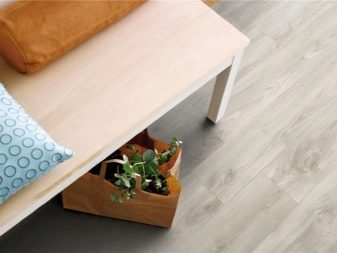
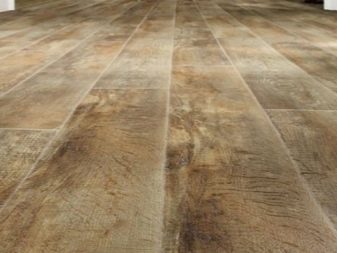
Applications
The use of laminate is not just limited to the floor.Due to the variety of textures, colors, the ability to imitate a variety of natural and artificial materials, the affordable price makes this material suitable for walls and ceilings. The use of laminate flooring allows you to quickly and easily create a flat, smooth surface, easy to clean and very durable. In residential premises, panels of the second class, more affordable in price, are quite suitable for these purposes. It is especially important to use laminated panels as a wall covering in rooms where there are small children or pets.
The original appearance of the finish remains 2-3 times longer.
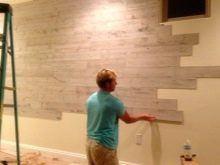
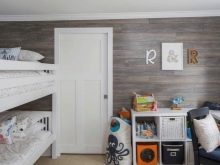
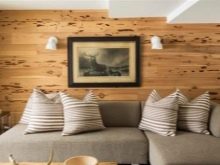
In the kitchen, sections of the walls covered with a laminate combined with a floor covering of the same material will not only allow creating an original and modern design, but also greatly facilitate the work of the hostess, since the top layer impregnated with resins is easy to clean, it does not leave stains and fat traces. All these qualities and ease of installation determine the growing popularity of this material for finishing ceilings. When properly laid, the joints between the panels are almost invisible. Walls and ceilings lined with laminate, in addition to undeniable aesthetics, practicality and durability, also acquire additional sound and heat insulation.
This material allows you to easily hide both surface irregularities and various elements of communications: wires, air vents, insulating materials.
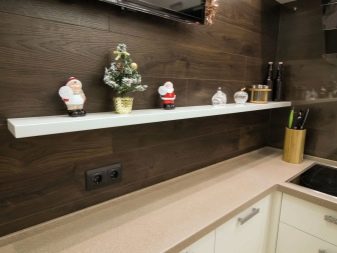

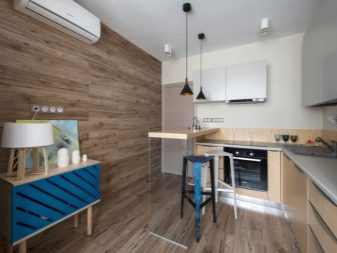
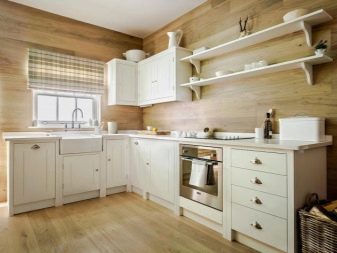
Installation of laminated flooring allows you to do without unnecessary noise and dirt, does not require high-tech tools and expensive consumables, it is quite accessible for self-assembly even for beginners. Vinyl laminate, due to its water resistance, can be used in bathrooms, toilets, and other rooms with high humidity. Antibacterial properties protect surfaces from the development of bacteria and the spread of mold.
Lamination allows you to create a durable coating for the exterior of facades, balconies, parapets. In addition to all the listed properties, they are protected from vandalism, atmospheric agents, and chemical attack. High pressure laminate (HPL panels) has been created for the finishing of external surfaces and aprons. These large-format slabs are impregnated with special thermosetting resins, the process of pressing them is carried out under high pressure and temperature, as a result of which the slab becomes monolithic.
A special acrylic coating creates additional protection, allows you to reproduce any texture and color scheme.
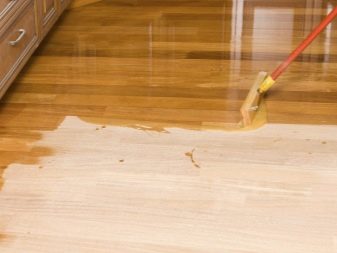

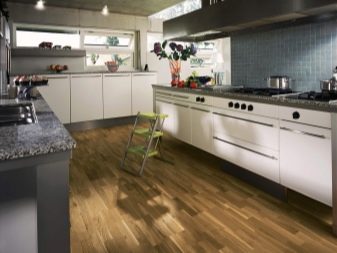
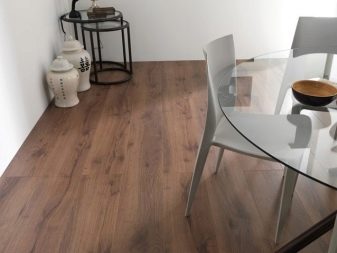
The stoves are practically not confirmed by the effect of even open fire and do not conduct electricity. Of course, the cost of such a coating is quite high, and during installation, additional crate is required, but these disadvantages are compensated for by a long (over 50 years) service life.
Design
Laminate flooring is deservedly loved by designers. This is due to the ability to bring to life any interior solution without increasing the cost of the project. The creation of new collections does not require large material costs. Along with the traditional shades of gray, white, brown, black, a huge variety of colors of light and dark shades are offered.
Modern trends in interior design involve the widespread use of very expensive materials: wood of various species, stone, ceramics.
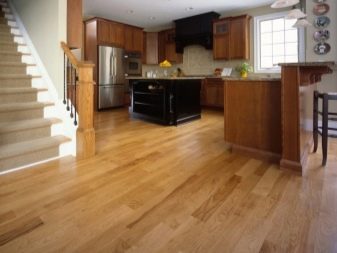
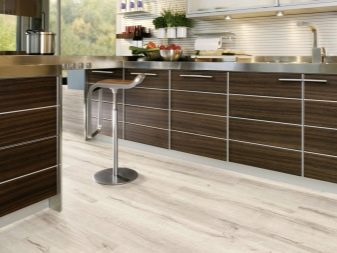

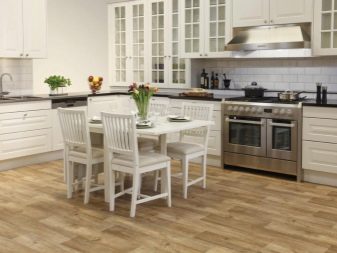
Tiles with different patterns, rough and smooth surfaces, laid in arbitrary directions, are relevant. Only laminate flooring is currently capable of fully imitating these materials. This quality, combined with ease of installation, allows you to create an ideal kitchen interior, while being quite affordable in price and meeting the increased hygienic requirements for this room.
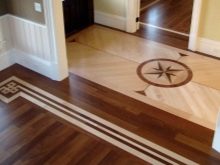
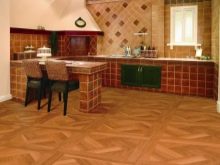

Selection recommendations
The criteria for choosing a laminate for kitchen decoration are as follows.
- Surface Considerationon which the material will be laid (floor, ceiling, walls, work wall near the stove and sink). First of all, the laminated coating for the kitchen must be able to resist not only splashes and drops of liquid, but also a fairly large amount of moisture and even flooding.
- Material class. The kitchen is the most visited room, and all surfaces in it are subject to wet cleaning much more often, so the strength class should be high enough.
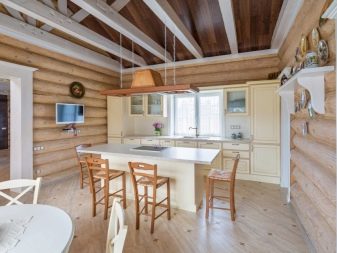
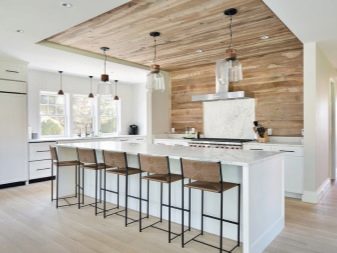
- Quality. Long-term preservation of the declared characteristics can only ensure a good quality laminate. The environmental friendliness of the coating, its anti-allergenic and antibacterial properties also depend on the quality.
- Design requirements (color, size, texture). When developing a room design, the choice of laminate will be influenced by the color of the kitchen set. Floor and wall finishes can be either neutral or contrasting. Skillfully selected colors will highlight the dignity of both furniture and coatings.
- Connection type. The best option for the kitchen is a reliable lock connection. In addition to moisture, the safety of the coating is also threatened by the fall of heavy objects, more frequent chips and scratches. The lock connection will allow replacing a deformed, swollen or damaged panel without replacing the entire surface.
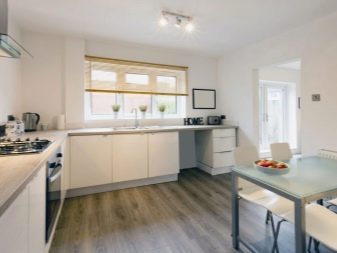
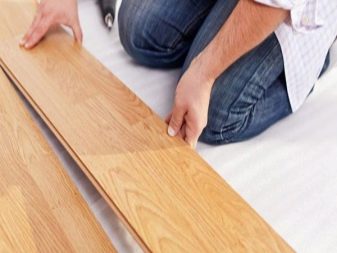
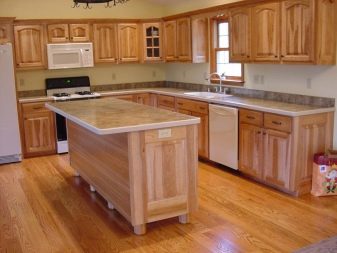
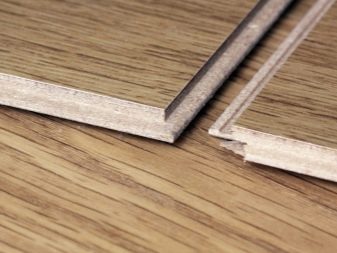
Operating rules
Laminate - the coating is quite unpretentious, reliable and easy to maintain. But the longevity of its service directly depends on the correct installation and operation.
The main factors that can lead to tile deterioration.
- Abrupt impact of heavy and sharp objects. It is very difficult to avoid falling knives in the kitchen; furniture, refrigerator, stove can be moved. Even a coating of high strength class is not immune from these phenomena. To remedy the situation, it is worth picking up special pencils or markers of a suitable shade to mask cracks, scratches, chips. Felt or felt pads can be glued to the furniture legs.
- Heavy pollution. It is easy to clean the surface from grease and stains with special products, the components of which are selected taking into account the characteristics of the laminated coating, you should not scrape it or clean it with aggressive detergents.
- High humidity. It is better to protect even the highest quality laminate from excess water; it is enough to thoroughly vacuum it and wipe it with a wrung out soft cloth. Lemon juice or a tablespoon of 9% vinegar added to the water for cleaning will help to preserve shine and give the coating a well-groomed appearance, no additional chemicals are required for this.

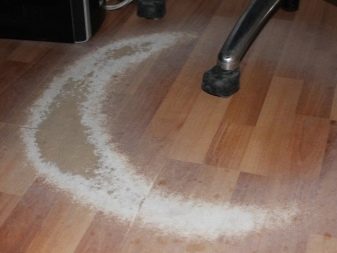
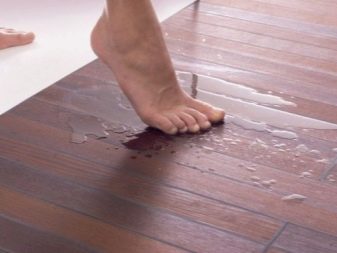
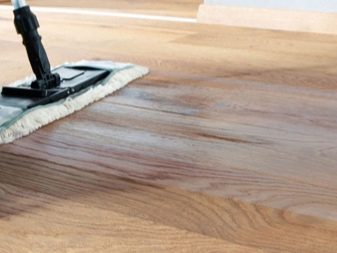
Expert reviews and advice
When choosing laminate flooring for the kitchen and installation methods it is very important to take into account the opinion of experts.
- Calculation of the amount of material. It is necessary to purchase about 10% more than calculated, since adjustment is often necessary during installation, especially in a room with a non-standard configuration. In addition, many types of laminate flooring allow one or more damaged panels to be replaced. The stock will allow you to avoid difficulties in the selection of tiles.
- Do not ignore the recommendations of the manufacturers. Even the most experienced craftsman should familiarize himself with the attached instructions, which indicate the features of installation and operation.
- Preparation of the base. The surface on which the laminate will be laid must be leveled and waterproofed as much as possible.
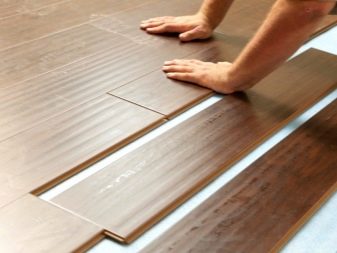

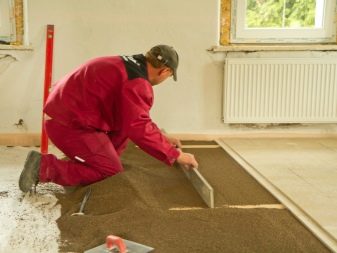
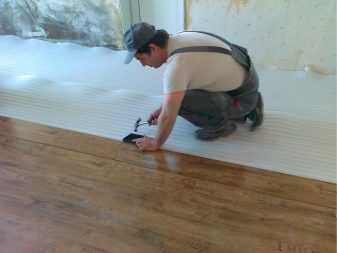
- Styling methods. It is quite difficult to lay the laminate diagonally, the material consumption increases, therefore it is recommended to lay the tiles along or across the room.
- Appearance. Experts believe that the most suitable option for the kitchen is a laminate made "under the tiles". As a rule, it is treated with antistatic agents and therefore attracts less dust. In a small kitchen, it is better to put a coating of light shades and the same color, since a combination of tiles of different colors will visually reduce the room.
- Tile size. Larger panels avoid unnecessary seams and are more cost effective. To mask the joints, experts recommend laying the laminate in the direction of the daylight falling from the window.
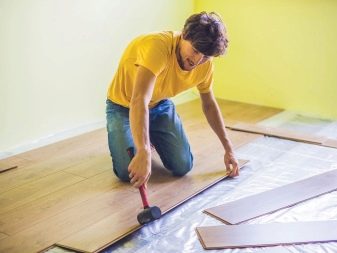
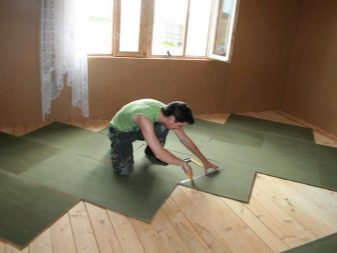

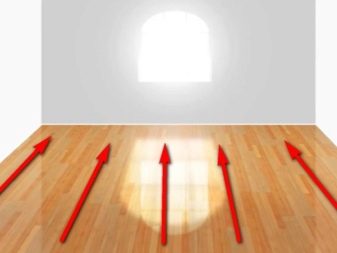
Beautiful examples
The versatility of the laminate, its ability to photographically copy various coatings, the variety of colors and shades allow designers to create beautiful, unique interiors at an affordable project cost.
- Laminate on the kitchen floor

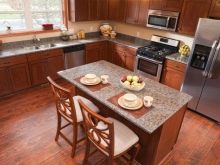
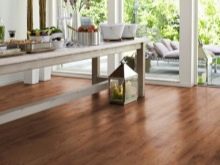
- Laminate in the design of the kitchen

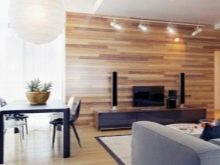
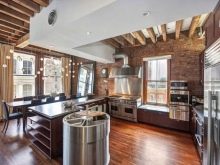
For tips on choosing a laminate for the kitchen, see the video below.










The comment was sent successfully.